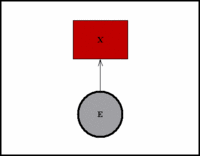 Did you know that now there is a field called spatial logic?
Did you know that now there is a field called spatial logic?I didn't. But it makes sense that such a field should exist. I welcome it!
Confession and avoidance: I did know that serious people had been thinking hard about making rational decisions and judgments about actions and events in three-dimensional space. I just didn't know that some people had begun to call reasoning about actions or events in three-dimensional space a logic.
Well, now that we have this new logic, there is an interesting possibility. You will recall that I have mentioned temporal logic from time to time. I can't say that I am proficient in the technicalities of temporal logic. Hardly! But now it is inevitable that we shall have a new logic: spatio-temporal logic.
I confess I did not come up with this idea on my own. Rather, I saw a paper with the intriguing title Combining Spatial and Temporal Logics: Expressiveness vs. Complexity (2005). The paper is by D. Gabelia, R. Kurucz, F. Wolter & Zakaharyaschev. Judging by the impressive and extensive technical detail in the paper, people have been hard at work at combining spatial and temporal logics for quite some time.
As the title of the paper suggests, combining the two logics aggravates combinatorial problems -- before all combinatorial explosion problems have been solved in stationary and one-dimensional worlds with a lot of details. Why are to welcome this additional aggravation?
Well, perhaps we should. I can't expatiate at length about this now -- but consider that adding space to time raises some very interesting (and baffling) questions about the law's assumptions about the way the world (cosmos) works. For example, suppose we assume three-dimensional settings rather than one-dimensional time lines or scenarios. Where do "mental events" and "decisions" go in the three- (and four-) dimensional picture?
This question brings to mind another intriguing paper whose argument I can only sniff in by osmosis here and there if at all: P.J. Gmytrsaciewicz & P. Doshi, A Framework for Sequential Planning in Multi-Agent Settings (2005). The abstract states in part:
Agents maintain beliefs over physical states of the environment and over models of other agents .... ... Models of other agents may include their belief states and are related to agents types in games of incomplete information. We ... [postulate] that ... models [of agents] are not directly manipulable or observable. ... [We take a certain approach] at the cost of having to represent, process and continuously revise models of other agents.In the paper the authors state:
The main idea behind our formalism, called interactive POMDPs [interactive partially observable Markov decision processes] (I-POMDPs), is to allow agents to use more sophisticated constructs to model and predict behavior of other agents. Thus, we replace the "flat" beliefs about the state space used in PODPs with beliefs about the physical environment and about the other agent(s), possibly in terms of their preferences, capabilities, and beliefs. Such beliefs could include beliefs about others ... They are called interactive beliefs. ...I like it! Now we're getting somewhere -- i.e. into a position where we can begin to think (systematically) a bit of the way that litigators think about litigation and the other actors in litigation. But ... hmmm ... how do we get spatial logic into this picture? The thought of doing something like that is literally mind-numbing. Of course, another question is whether building three-dimensional space into the picture of multi-agent interactive processes such as litigation would be at all useful. I think the answer must be: yes, sometimes.

No comments:
Post a Comment